
| What is Flavor and Fortune? |
| How do I subscribe? |
| How do I get past issues? |
| How do I advertise? |
| How do I contact the editor? |
Read 12749193 times
Connect me to:
| Home |
| Articles |
| Book reviews |
| Letters to the Editor |
| Newmans News and Notes |
| Recipes |
| Restaurant reviews |
| Article Index (all years, slow) |
| List of Article Years |
| Article Index (2025) |
| Article Index (last 2 years) |
| Things others say |
| Related Links |
| Log In... |
| Authors |
| Categories & Topics |
TOPICS INCLUDE: Rice; Birthday banquet; Unusual ingredients; Huangdi's oxtail; Gorgon fruit; Casserole Lauren; Spare-ribs with vegetable; Dinner kits; Citrus tea; Basil seeds; Book award
| by Jacqueline M. Newman |
Letters to the Editor
Summer Volume: 2008 Issue: 15(2) page(s): 7, 8, 9, 10, and 15
FROM AMY via e-mail:
Are readers aware that not all rice is 'all rice?'
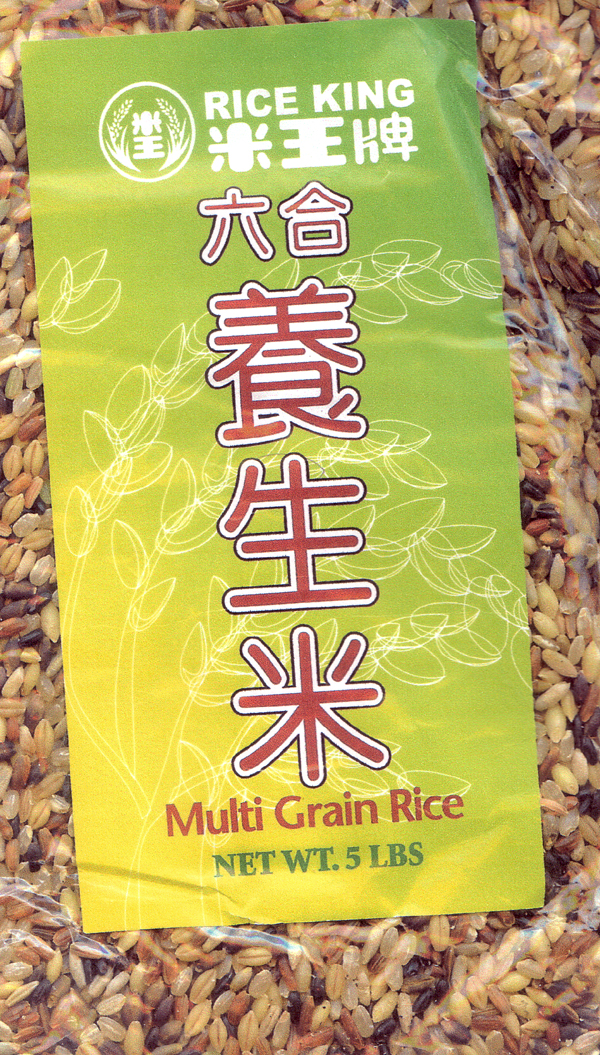 AMY:Thank you for calling this to the attention of all. This 'Multi-grain Rice' package pictured here says it is a product of the U.S.A. It is packed for a New Jersey company, and the label says it includes: Short grain brown rice, hulless barley, French red rice, Rye berris (spelling as printed on the package), purple barley, and black Japanico rice. Three of its six items are not rice. Therefore, this product should not be consumed by those with celiac disease. We did buy a five pound bag to prepare this multi-grain item. While it was delicious, we are disappointed that it and many other multi-grain products are not what their name says they are. Furthermore, they should not be consumed by people with this health condition. We think, as does Amy, they should not be labeled 'multi-grain rice.'
AMY:Thank you for calling this to the attention of all. This 'Multi-grain Rice' package pictured here says it is a product of the U.S.A. It is packed for a New Jersey company, and the label says it includes: Short grain brown rice, hulless barley, French red rice, Rye berris (spelling as printed on the package), purple barley, and black Japanico rice. Three of its six items are not rice. Therefore, this product should not be consumed by those with celiac disease. We did buy a five pound bag to prepare this multi-grain item. While it was delicious, we are disappointed that it and many other multi-grain products are not what their name says they are. Furthermore, they should not be consumed by people with this health condition. We think, as does Amy, they should not be labeled 'multi-grain rice.'
FROM JEAN via e-mail:
My birthday banquet, akin to yours, and also at Ocean Jewel Seafood Restaurant in Flushing, New York, was superb. After hearing about yours, we ordered wintermelon soup in the whole melon, and also the duck, lamb chop, lobster and many of the same dishes you had. The room was pretty and the service excellent. We were all delighted, and I personally want to thank you for your helpful advice. Because of that help, I could plan my party from New Hampshire at a sight-unseen place far from my usual haunts. I felt confident it would work; and it did.
JEAN: Delighted you were delighted. You and others can read about and see pictures of some of the dishes at your banquet and mine that were in the article titled: Banquet Protocols, an Example in Volume 15(1) on pages 29-30, and 32. A belated Happy Birthday!
FROM MARION via e-mail:
I love the recipes; however living in Atlanta I have a hard time finding those exotic ingredients. Could you please suggest a place where I could find items like bamboo fungus, shark's fins, etc. I would like to order them shipped and as fresh as possible.
MARION: There are web sites that sell and ship Chinese ingredients including those you mentioned. However, before ordering you need to know that bamboo fungus is a dry ingredient as are shark's fins. We suggest that you and other readers ''Google'' for Chinese ingredients. For those who need fresh ones try: www.sidwainer.com They are used by many professionals; and if in the area, do visit their store to see many fresh, dried, canned, and others foods. They are so fresh, they are to salivate over. Other resources can be found at the New Asian Cuisine web site and others. At that particular site there are some posted items I wrote abour for Asian Restaurant News. Check them out along with many others web sites. Also look for places in Chinese cook books, magazines, phone books, etc.
FROM HELENE via e-mail:
Thanks for the article about what one recent Qing emperor (Qing-Long) ate. Do you or does anyone know anything about what China''s first emperor, Huangdi ate?
HELENE: For the record, Huangdi ruled from 259 to 210 BCE, and there are a few food facts about this ruler who gets credit for unifying China. They include his expertise in growing foods, in tasting them to see if they were poisonous, and lots more. As to 'what he ate,' we once read that on a tour of his empire, he went into an eatery and ordered beef. The owner had sold it all before he got there and so gave him an oxtail dish set aside for his very own dinner. The recipe given was for Braised Oxtail.
FROM WAN via e-mail:
Can you advise what is gorgon fruit and how do the Chinese use it?
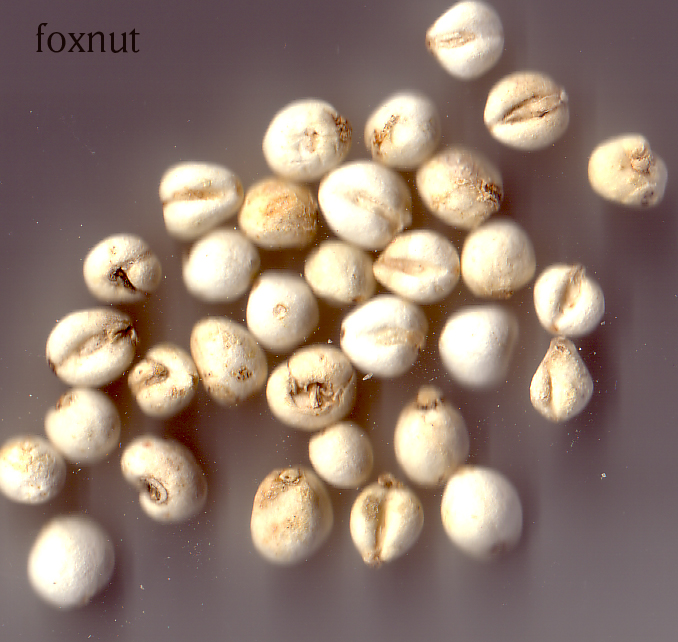 WAN: Gorgon fruit is also known as fox nut. It is a pulpy glutinous fruit-like seed that is highly esteemed in China. Botanically known as Euryale ferox, it is a source of starch. Its young stalks are edible as are its rhizomes and its fruit. Dried gorgon seeds are available in Chinatown markets. They are pictured on this page. Fresh or dried and then soaked, they can be pickled and they can be added to curry-type dishes. They can also be ground, and as a flour, used to make cakes. One source told us that fresh or dried, they can be cooked with longan making a sweet tonic soup. We have only located one gorgon recipe in a Chinese cookbook. It was for a vegetable wrap, and it is below.
WAN: Gorgon fruit is also known as fox nut. It is a pulpy glutinous fruit-like seed that is highly esteemed in China. Botanically known as Euryale ferox, it is a source of starch. Its young stalks are edible as are its rhizomes and its fruit. Dried gorgon seeds are available in Chinatown markets. They are pictured on this page. Fresh or dried and then soaked, they can be pickled and they can be added to curry-type dishes. They can also be ground, and as a flour, used to make cakes. One source told us that fresh or dried, they can be cooked with longan making a sweet tonic soup. We have only located one gorgon recipe in a Chinese cookbook. It was for a vegetable wrap, and it is below.
FROM LAUREN in many e-mails:
I am a fairly new subscriber to your wonderful magazine. My eight-year-old daughter, adopted from Zhanjiang, and I just returned from a two-week visit to China. I would love to find a recipe for a casserole dish of tender leafy greens in a slightly opaque, very slightly thickened broth topped with chopped salted duck egg and preserved eggs. Thank you for any information you can provide.
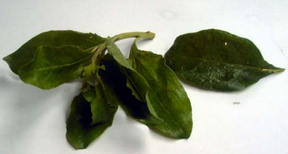
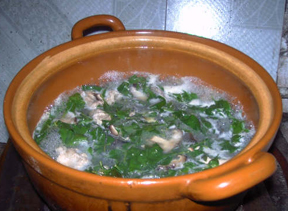
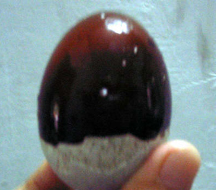 LAUREN: We were unable to learn about this dish or even most of its ingredients without the eventual help of your in-China translator. Therefore, we owe a collective thanks to you for putting us in touch with her. We also offer thanks to our good friend Lana who gave us her only goji plant so we could grow it, take off many of its leaves, and taste the dish. Readers need to know that your translater, Yorkee, provided the pictures of a rendition of this recipe that her sister made. We share that, too, on this page. With the exception of very few recipes in the books we review, we make and taste all recipes published in this magazine. The one from Yorkee had very few measurements, so we began doing some experimenting. Some weeks later, we actually found a recipe using goji leaves. With that, your, and Yorkee¡¯s information, the recipe below is a collective effort, that with editorial privilege, That is I named in your honor. For those who do not know, and early on we did not, Zhanjiang is south of Guangzhou and at the shore. This city has an orphanage where a large percentage of Chinese children adopted by folks in the United States hail from.
LAUREN: We were unable to learn about this dish or even most of its ingredients without the eventual help of your in-China translator. Therefore, we owe a collective thanks to you for putting us in touch with her. We also offer thanks to our good friend Lana who gave us her only goji plant so we could grow it, take off many of its leaves, and taste the dish. Readers need to know that your translater, Yorkee, provided the pictures of a rendition of this recipe that her sister made. We share that, too, on this page. With the exception of very few recipes in the books we review, we make and taste all recipes published in this magazine. The one from Yorkee had very few measurements, so we began doing some experimenting. Some weeks later, we actually found a recipe using goji leaves. With that, your, and Yorkee¡¯s information, the recipe below is a collective effort, that with editorial privilege, That is I named in your honor. For those who do not know, and early on we did not, Zhanjiang is south of Guangzhou and at the shore. This city has an orphanage where a large percentage of Chinese children adopted by folks in the United States hail from.
FROM TYROLE: via e-mail: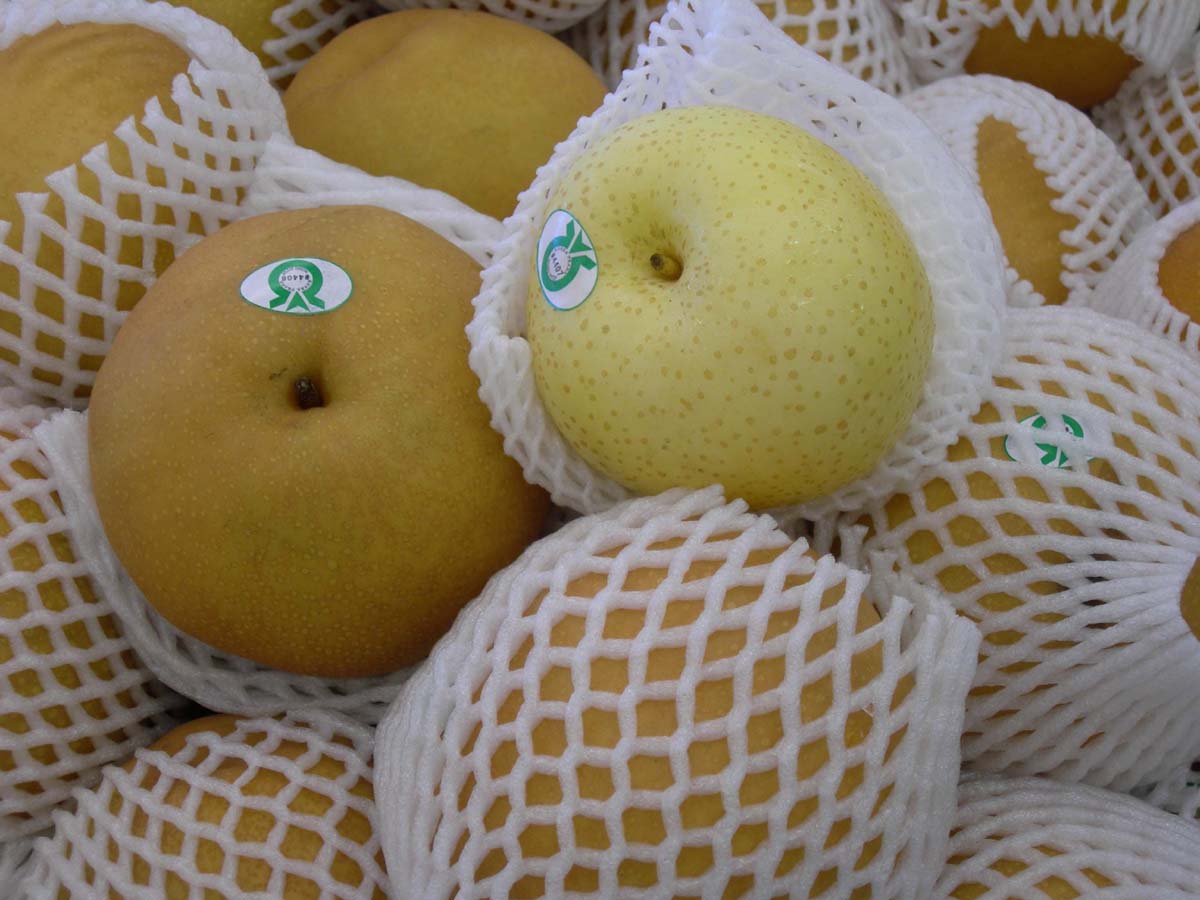 Recently in a small restaurant in Taipei, had a stuffed apple with something sweet in its core translated as 'plaster.' It was recommended to rid me of a dreadful cough. Any idea what was in that huge apple?
Recently in a small restaurant in Taipei, had a stuffed apple with something sweet in its core translated as 'plaster.' It was recommended to rid me of a dreadful cough. Any idea what was in that huge apple?
TYROLE: The dish you had, we believe was called Pear with Honey and Fritillaria. I was served this same soup daily for five days when in China some years back. The herbalist at the commune where I was said it would ease my hacking cough too. He made it for me using an Asian pear stuffed and steamed. This fruit does look like an apple, and its texture is as crisp as a freshly picked ripe apple. There was some ground powder and a sweetener in its core. Later, I learned it was ground fritillary bulb. That bulb, really a corm in the Liliaceae family, is called Fritillaria cirrhosa, and the Chinese Materia Medica considers it an expectorant and an antitussive food. They also say it is good as an anti-asthmatic.
Actually, there are two main varieties, one from Sichuan, the other is known as the Zhejiang variety. The former is produced in the province of Sichuan and in Yunnan, Gansu, and Tibet. The latter is from the province of Zhejiang in Xiang Shan county. It is commonly known as xiang. The one I think you had was the same as the one I did, the Sichuan variety. It is, in the Chinese dichotomy, considered bitter-sweet, and slightly cold. The other variety is believed to be simply cold and bitter with great capacity to clear heat. The drug made from either corm is known as song bei or qing bei.
Pear, honey, and Fritillaria is a simple dish to make. Ground bulb, really the corm of chuan bei mu---its Chinese name, is available at almost all Chinese herb stores. Asian pear (see the article about in this issue) has been called a Chinese pear, an apple-pear, and an Asian pear. To make this dish, wash and dry the fruit, then cut a half-inch off the top as a single piece. Reserve it. Core the fruit not cutting through the bottom, nor should you pierce the fruit in any way. For each fruit, put a teaspoon of the chuan bei powder in the core and top it with a tablespoon or two of honey. Put the top back on and secure it with two toothpicks. Set the pear in a small bowl and into a steamer basket. Over boiling water, steam it for twenty minutes, then remove it from the steamer. Serve warm or at room temperature.
PETE writes:
Loved the larger number of recipes in the last issue. That said, in Guangzhou we had a delicious sparerib dish with a vegetable they called kerala. It was sort of a bitter and sour cucumber with lots of very small warts over its entire exterior. Can you help locate a recipe; and most importantly, where can we buy kerala?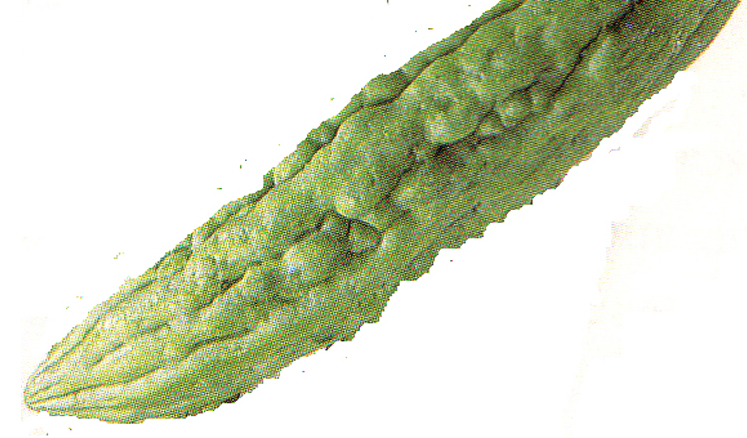 PETE: The dish is a popular Cantonese one, and can be made with bitter melon or with kerala which is more popular in India and Pakistan than in China. Usually both are available in Guangzhou and in most southern Chinese cities and in Asian markets worldwide. What is different about this variety is that the area around the seeds is white and not red. It has very bumpy exterior many more smaller bumps than the common bitter melon the Chinese use.
PETE: The dish is a popular Cantonese one, and can be made with bitter melon or with kerala which is more popular in India and Pakistan than in China. Usually both are available in Guangzhou and in most southern Chinese cities and in Asian markets worldwide. What is different about this variety is that the area around the seeds is white and not red. It has very bumpy exterior many more smaller bumps than the common bitter melon the Chinese use.
There is an article about bitter melon in this issue. The recipe at the end of these letters is Cantonese and can be made with bitter melon or kerala. If you like your vegetable less bitter, do not use kerala. For either of them cut the fruit in half, remove both pith and seeds and soak it for an hour or two in tepid water. For those who really like very bitter foods, do not bother soaking it.
CATHY asks in her e-mail:
Have you seen the Wanchai Ferry Dinner Kits? I heard about them but my market does not have any.
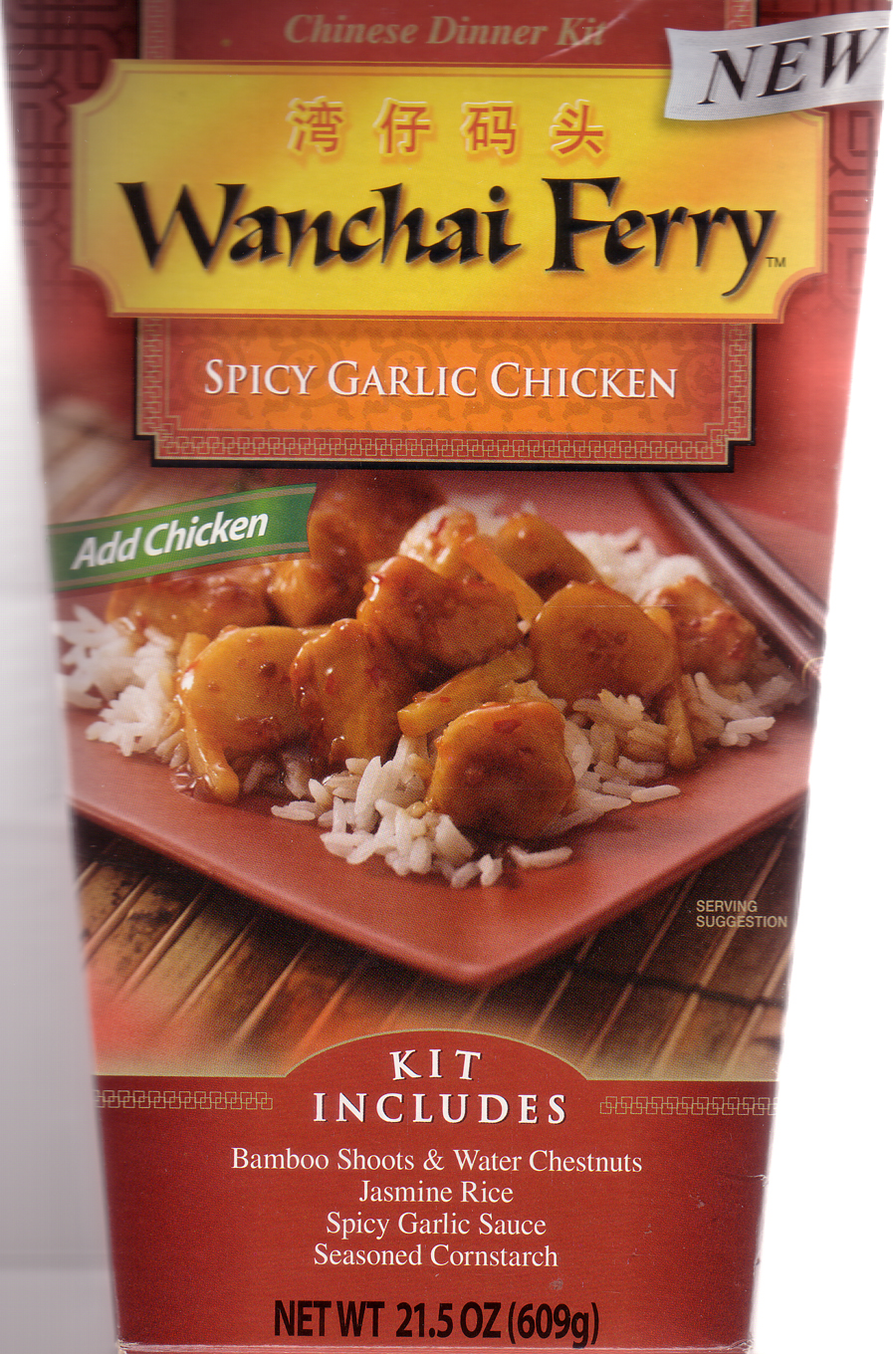 CATHY: Never heard of them until you queried us. Soon thereafter we did locate the Spicy Garlic Chicken variety on a supermarket shelf. We bought it for $4.59 without even reading the label. On the front, it was clearly marked 'Add Chicken' but we failed to notice that. We assumed there was some chicken inside this box made by General Mills.
CATHY: Never heard of them until you queried us. Soon thereafter we did locate the Spicy Garlic Chicken variety on a supermarket shelf. We bought it for $4.59 without even reading the label. On the front, it was clearly marked 'Add Chicken' but we failed to notice that. We assumed there was some chicken inside this box made by General Mills.
The box says 'thanks to an original recipe of Madame Chong who in 1977 arrived in Hong Kong from Qing Dao and pushed a cart around the Wanchai Pier selling handmade dumplings using an old family recipe.' Turns out that in 1985 she established the Wanchai Ferry Peking Dumpling company to fill a growing demand, she says, for her delicious dumplings. We learned there are four Dinner Kit flavors; the others are Sweet & Sour Chicken, Kung Pao Chicken, and Cashew Chicken with Dumplings.
The PR for this product says it is available in Asia and France. Inside the box is a plastic bag with a cup of dry Jasmine rice, a bag labeled Spicy Garlic Seasoned Cornstarch, and a can of bamboo shoot sticks and sliced water chestnuts in water. There is also a plastic/aluminum foil packet of Spicy Garlic Sauce. This box says preparation time is about thirty minutes and that the contents serves six. We made it in twenty-five and it barely fed just two of us.
Based upon the only box we bought, made, and ate, the taste is better than many Chinese take-out chicken dishes. The amount of rice cooks up to two far-from-full Chinese rice bowls. It did feed two of us along with a green vegetable dish (a requirement in our home) and a cup and a half of other leftovers from a Chinese restaurant. The sauce was gluey but tasty, and a bit salty. The can of vegetables violated our understanding of Chinese cuisine because each size and shape was far from uniform. We did cut the chicken, as instructed into one-inch pieces and they went with the very thin strips of bamboo shoots and thin slices of water chestnuts (both rather tasteless).
We commend General Mills for entering the Chinese market with a make-at-home Dinner Kit, but do suggest reducing the number of folks the product says it serves. Even four is not realistic for adults for dinner. To make it healthier, they should suggest adding a green vegetable, themselves, they should reduce the salt or package it separately for those who need or want lower amounts of sodium.
FROM ELLIE vis e-mail:
Just received a package of a citrus peel, and was told it was tangerine, and great for tea. Can you tell us something about it?
ELLIE: The tangerine fruit is called zhu ju, its peel known as zhu pi or chen pi. This skin is the peel of a fruit growing on an evergreen tree botanically known as Citrus reticulata. Both peel and fruit have medicinal value. The skin or peel, the Chinese say, travels in lung and stomach meridians or channels. The fruit is considered cool, the peel believed warm, we were told by traditional Chinese herbal practitioners. They use the peel to eliminate dampness in the stomach, balance one's qi, and get rid of phlegm. They also use it to aid the lungs and ease a cough, and too relieve abdominal/digestive problems.
You might want to save tangerine rind and dry it. We have dried some in the oven. Chinese like tangerine peel from special trees grown in special places, so most of them purchase theirs dried. They make an herbal tangerine tea for irritated throats, and a friend of ours adds peppermint to hers. An herbal doctor friend cringed at that thought. He read the above paragraphs and told me to remind my readers to drink tangerine tea when very hot and to use it if they have a sinus headache.
FROM ANDREA in Hempstead:
What soups are brown basil seeds used in?
ANDREA: To the best of our knowledge, the brown seeds you described are used in cold soups and as a Chinese medicine. They are more common in Cambodia than in China, except for medicinal purposes in both countries. When soaked, these seeds swell and become reddish. When mixed with sugar they make a refreshing cold soup or drink used in hot humid weather. The seeds are from a very tall tree and though some call them basil seeds, that name is not correct. True basil seeds are bluish-black. We think the confusion is because the soup they are used with sometimes has basil seeds added. Botanically, the seeds are Sterculia lychnophore.
FROM HARRIET in Nebraska:
Why no picture of the book about banquets that I queried about and you responded to in Volume 14(4) on page 17. I would like it to show to my bookstore friend.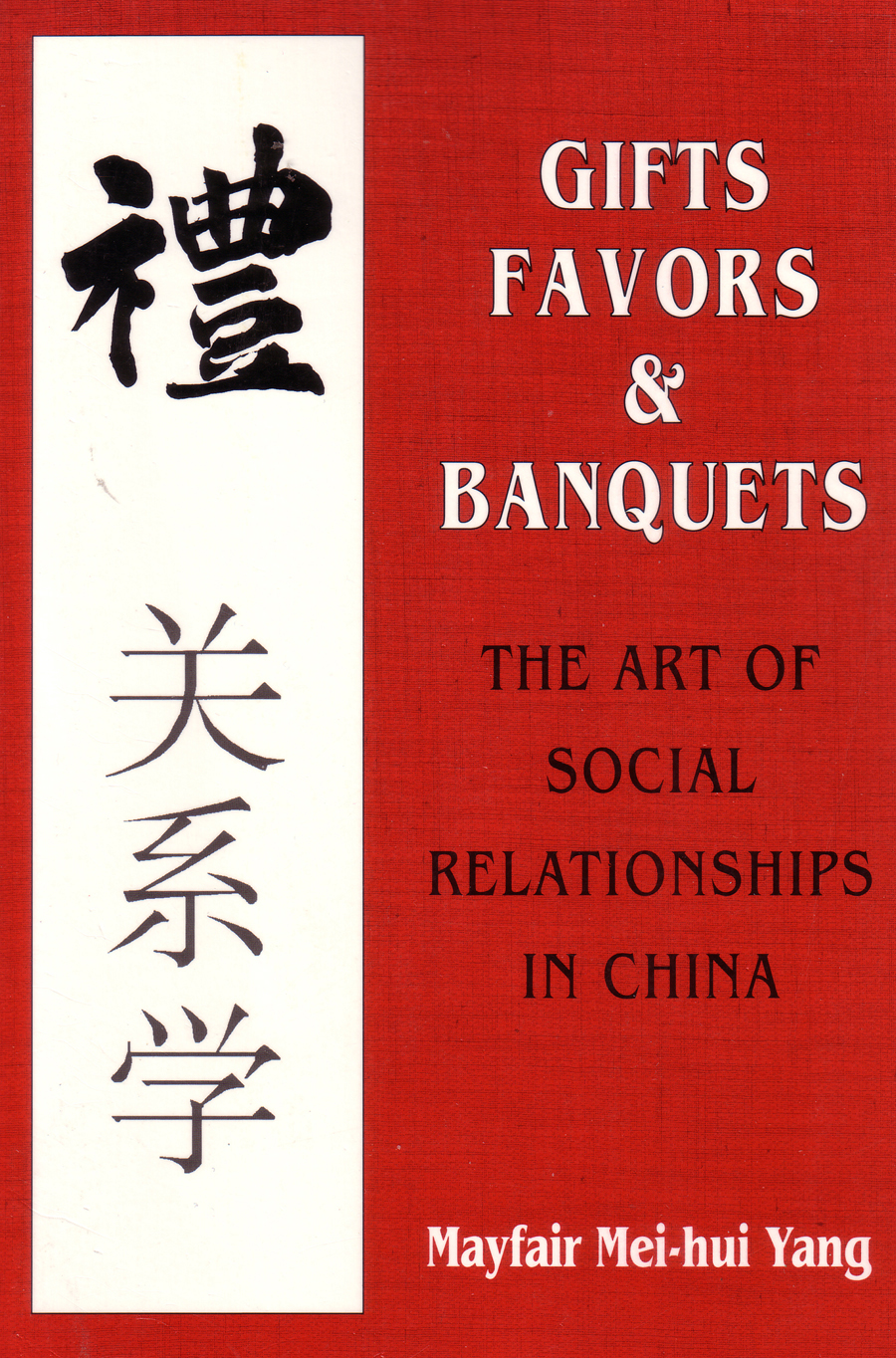
HARRIET: Our apologies. The book about banquets that is fascinating but of little to no help in planning one is pictured here. The publisher is Cornell University Press, the date published is 1994.
FROM JO MARIE via e-mail:
Great news about the book you reviewed by Dorothy Duncan. It won the gold award in the Canadian Food Culture category in the Canadian Culinary Book Awards 2007. The author, her book, and those of other winners can be seen at: www.lib.uoguelph.ca/resources/archives/culinary/cuisine-canada/winners.htm
JO MARIE: Thanks for advising; and congratulations to the author for an award well deserved. Those interested in more information. Please contact Ali Pennels, The Dundurn Group at (416) 214-5544 ext. 222 or e-mail apennels@dundurn.com
| Braised Spicy Oxtail |
|---|
1 oxtail, 2-3 pounds, cut into two-inch pieces 2 Tablespoons thin soy sauce 1 Tablespoon Chinese rice wine 1/2 teaspoon salt 2 cups vegetable oil 2 scallions 1 teaspoon Sichuan pepper 3 dried red chili peppers 1 teaspoon ground white pepper 2 pieces, about two teaspoons, of licorice pieces 4 whole star anise 1 quart chicken broth 1/2 cup one-inch carrot chunks, cut on an angle 1/2 cup canned bamboo shoots, cut to match the carrots 3 Tablespoons cornstarch mixed with two tablespoons cold water Preparation: 1. Marinate oxtail in a mixture of soy sauce, rice wine, and salt for half an hour. The remove and reserve the marinade. 2. In a wok or deep pot, heat oil and deep-fry the oxtail pieces until they are crisp on the outside. Drain them and set the oil aside for some other use. 3. Add oxtail, reserved marinade, and the scallions, Sichuan pepper, chili peppers, ground white pepper, licorice pieces, star anise and the chicken broth. Bring this almost to the boil, reduce heat and cover the pot, Simmer for two and a half hours or until meat is tender enough to be removed from the oxtail bones with chopsticks. 4. Remove oxtail to a bowl, then strain the liquid and discard any solids. Return liquid, the oxtails and the carrots and bamboo shoots to the pot, and simmer uncovered for fifteen minutes. Then add cornstarch water, stir, and bring the liquid to the boil, stirring until it thickens and clears. Then serve.
|
| Golden Vegetable Wraps |
|---|
1 Tablespoon dried gorgon fruit 1 teaspoon vegetable oil 1 clove garlic, slivered 2 Tablespoons slivered taro 5 sugar snap peas, strings removed and slivered the long way 10 enoki mushrooms 1 teaspoon shredded wax gourd or another gourd 2 teaspoons shredded purple yam 1 large Chinese black mushroom, soaked until soft, stem discarded, and slivered 3 Tablespoons slivered Chinese pumpkin 2 asparagus, cut in two-inch lengths, then slivered 1/2 baby bok cai, cut in two-inch lengths, and slivered 1 teaspoon qoji berries, each cut in three or four, the long way salt and ground white pepper, to taste 2 spring roll wrappers Preparation: 1. Soak gorgon fruit in warm water for half an hour, then steam for fifteen minutes over rapidly boiling water. Cool, and sliver. 2. Heat wok or large fry pan, fry garlic for one minute until fragrant, and remove from the oil and put into a large bowl. 3. Mix gorgon fruit, garlic, and the slivered taro, sugar snap peas, enoki mushrooms, wax gourd, purple yam, black mushroom, asparagus, bok cai, and the giji berries, and put half on the edge of each spring roll, Fold one end in and roll closed, narrower at the folded end, wider at the other which will be the top of the wrap. Try not to put too much filling at the wider end. 4. Reheat wok or fry pan and fry the wraps until golden and crisp. Then serve.
|
| Spareribs with Bitter Melon |
|---|
1 pound spare ribs, cut into one-inch pieces 1 teaspoon cornstarch 2 kerala or bitter melons, cut in half the long way, seeds and pith removed 1 teaspoon coarse salt 2 scallions, cut in half-inch pieces, on an angle 2 Tablespoons fresh minced ginger 3 cloves garlic, peeled and minced 1/2 cup fermented black beans, rinsed and coarsely chopped 3 Tablespoons vegetable oil 1 teaspoon soy sauce 1 teaspoon sugar 1 Tablespoon oyster flavored sauce 1/8 teaspoon ground black pepper 1 Tablespoon cornstarch mixed with an equal amount of cold water Preparation: 1. Mix spareribs with the teaspoon of cornstarch, and set aside for twenty minutes until cornstarch is wet and no longer white. 2. Angle-cut the prepared kerala or bitter melon into half-inch wide slices, and mix with he scallion pieces. 3. Mix ginger, garlic, and mashed black beans. 4. Heat wok or fry pan and add the oil, then the black bean mixture and stir-fry for one minute before adding the spare ribs and the kerala or bitter melon pieces. Stir-fry for five minutes until the spareribs are browned. Then add half cup of boiling water, the soy sauce, sugar, oyster flavored sauce, and the ground black pepper. Reduce the heat and simmer for half an hour. 5. Stir in the cornstarch water, raise heat and boil and stir until the sauce clears and it thickened, then serve.
|
| Zhanjiang Casserole Lauren |
|---|
1 large pork chop or four large pork ribs 3 cloves whole garlic, peeled and lightly crushed with side of a cleaver 4 Chinese black mushrooms, soaked, stems removed, and cut in quarters 1 cup leafy goji greens (or substitute amaranth leaves) 1 or 2 preserved duck eggs (pidan), peeled and then diced Preparation: 1. Into a stove-top casserole, add pork, garlic, mushrooms and five cups of water. Cook just below the boil until the meat is extra tender, and the water turns more cloudy than clear. Remove meat and bones and discard both. Strain, if necessary. 2. Add goji greens and cut up duck eggs, and simmer for five minutes, then serve.
|
| Tangerine Tea |
|---|
2 dried tangerine peels, broken into half-inch or smaller pieces 4 slices fresh ginger, peel left on, and smashed with side of a cleaver 6 large peeled Chinese almonds 2 scallions, each tied into a knot 1/2 to 1 teaspoon honey Preparation: 1. Soak tangerine peel in one cup of warm water for one hour. 2. Put tangerine peel, the water it soaked in and another cup of warm water, the ginger, almonds, and the knotted scallions in a pot and bring to the boil. After two minutes, remove the scallions and discard or use in a soup. 3. Add the honey, boil one more minute, then serve.
|

Copyright © 1994-2025 by ISACC, all rights reserved
Address
3 Jefferson Ferry Drive
S. Setauket NY 11720